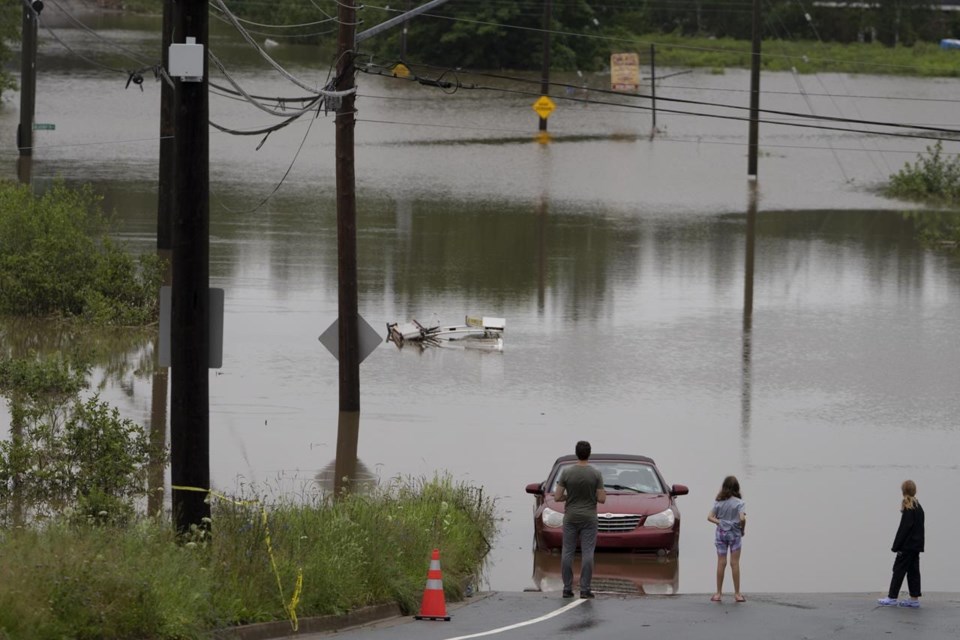HALIFAX — After last summer's heat waves, deadly floods and record-breaking wildfires, some scientists are urging Canadian health professionals to help their patients better prepare for climate change-related extreme weather and natural disasters.
Blair Feltmate, head of the Intact Centre on Climate Adaptation at the University of Waterloo, told a national public health conference in Halifax Wednesday there are inexpensive and effective ways of reducing harm caused by climate-related disasters — some of which are as simple as cleaning out gutters, backwater valves, storm drains or installing blinds in windows.
"We have known, deployable, cost-effective solutions to mitigate some risk being realized in this country due to flooding, wildfire and extreme heat in particular,” Feltmate told an audience of about 750 Wednesday.
“And we are not deploying those solutions quickly enough.”
Feltmate said health facilities should print and share with patients the detailed infographics his centre has prepared that lay out a range of things people can do ahead of extreme heat, wildfires and floods. The centre has distilled its research into a range of one-page, illustrated resources — each with a specific focus.
They include one for protecting your home from flooding, one for managing extreme heat in an apartment or condo and a protection guide for people who live in wildfire risk areas.
Many of the upgrades listed cost very little or nothing, like removing mulch and plants from right next to your home if you live in a wildfire-risk area, checking for leaks in plumbing, and using heat-resistant curtains and fans to cool your home during a heat wave. More costly recommendations include installing a sump pump, adding non-combustible screens to external vents and replacing wooden fencing near the house with wire or metal fence.
Feltmate said in an interview Wednesday that the fire safety precautions his centre has identified can reduce by 50 to 75 per cent the probability of a house being destroyed if a wildfire moves through the region.
Wednesday’s conference session was led by Canada’s chief public health officer, Dr. Theresa Tam, who told the gathered health professionals that climate change should be front of mind because it will affect all aspects of public health.
“The public health audience can appreciate the profound effects of climate change on a wide range of physical and mental health impacts, and indeed the health and well-being of our communities,” she said at the conference.
Those effects, she said, include "infectious diseases … water-borne diseases, respiratory and cardiovascular problems, heat strokes, dehydration and mental health impacts that are affecting all populations."
Feltmate said it's crucial to share tips that may help protect people and their homes from climate-related disasters because “climate change is here to stay.”
“It's irreversible, and I don't mean that we shouldn't be doing everything to slow down the discharge of greenhouse gases into the atmosphere, we should be doing everything we can to slow things down,” he said.
“But we're not going to reverse climate change. It will get worse going forward, which means we have to step up and address it,” he added.
Persistent drought and months of above-average temperatures have raised the risk of a repeat of last year's record-breaking wildfires, prompting federal ministers to warn on April 10 about the need to address climate change.
The 2023 fire season was Canada's worst on record, burning more than 15 million hectares and forcing more than 230,000 people from their homes. It also created unprecedented smoke conditions across much of the country and in the United States.
A federal briefing document forecasting the fire risk for the spring shows conditions are already ripe this year for an early and above-normal fire risk from Quebec to British Columbia in both April and May. The forecast is based on Canada having had a warmer than normal winter with minimal snow and widespread drought, particularly in the Prairies. There is also a high probability for above-normal temperatures in April, May and June.
This report by The Canadian Press was first published April 24, 2024.
Lyndsay Armstrong, The Canadian Press




